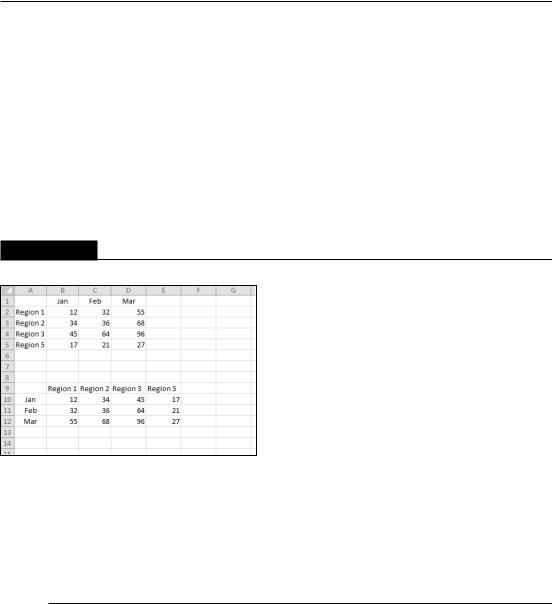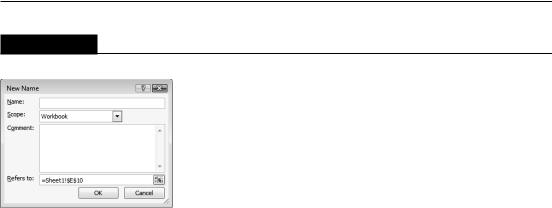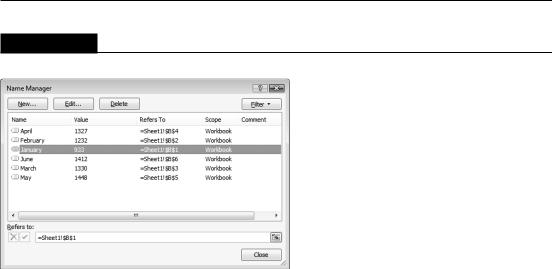
- •About the Author
- •About the Technical Editor
- •Credits
- •Is This Book for You?
- •Software Versions
- •Conventions This Book Uses
- •What the Icons Mean
- •How This Book Is Organized
- •How to Use This Book
- •What’s on the Companion CD
- •What Is Excel Good For?
- •What’s New in Excel 2010?
- •Moving around a Worksheet
- •Introducing the Ribbon
- •Using Shortcut Menus
- •Customizing Your Quick Access Toolbar
- •Working with Dialog Boxes
- •Using the Task Pane
- •Creating Your First Excel Worksheet
- •Entering Text and Values into Your Worksheets
- •Entering Dates and Times into Your Worksheets
- •Modifying Cell Contents
- •Applying Number Formatting
- •Controlling the Worksheet View
- •Working with Rows and Columns
- •Understanding Cells and Ranges
- •Copying or Moving Ranges
- •Using Names to Work with Ranges
- •Adding Comments to Cells
- •What Is a Table?
- •Creating a Table
- •Changing the Look of a Table
- •Working with Tables
- •Getting to Know the Formatting Tools
- •Changing Text Alignment
- •Using Colors and Shading
- •Adding Borders and Lines
- •Adding a Background Image to a Worksheet
- •Using Named Styles for Easier Formatting
- •Understanding Document Themes
- •Creating a New Workbook
- •Opening an Existing Workbook
- •Saving a Workbook
- •Using AutoRecover
- •Specifying a Password
- •Organizing Your Files
- •Other Workbook Info Options
- •Closing Workbooks
- •Safeguarding Your Work
- •Excel File Compatibility
- •Exploring Excel Templates
- •Understanding Custom Excel Templates
- •Printing with One Click
- •Changing Your Page View
- •Adjusting Common Page Setup Settings
- •Adding a Header or Footer to Your Reports
- •Copying Page Setup Settings across Sheets
- •Preventing Certain Cells from Being Printed
- •Preventing Objects from Being Printed
- •Creating Custom Views of Your Worksheet
- •Understanding Formula Basics
- •Entering Formulas into Your Worksheets
- •Editing Formulas
- •Using Cell References in Formulas
- •Using Formulas in Tables
- •Correcting Common Formula Errors
- •Using Advanced Naming Techniques
- •Tips for Working with Formulas
- •A Few Words about Text
- •Text Functions
- •Advanced Text Formulas
- •Date-Related Worksheet Functions
- •Time-Related Functions
- •Basic Counting Formulas
- •Advanced Counting Formulas
- •Summing Formulas
- •Conditional Sums Using a Single Criterion
- •Conditional Sums Using Multiple Criteria
- •Introducing Lookup Formulas
- •Functions Relevant to Lookups
- •Basic Lookup Formulas
- •Specialized Lookup Formulas
- •The Time Value of Money
- •Loan Calculations
- •Investment Calculations
- •Depreciation Calculations
- •Understanding Array Formulas
- •Understanding the Dimensions of an Array
- •Naming Array Constants
- •Working with Array Formulas
- •Using Multicell Array Formulas
- •Using Single-Cell Array Formulas
- •Working with Multicell Array Formulas
- •What Is a Chart?
- •Understanding How Excel Handles Charts
- •Creating a Chart
- •Working with Charts
- •Understanding Chart Types
- •Learning More
- •Selecting Chart Elements
- •User Interface Choices for Modifying Chart Elements
- •Modifying the Chart Area
- •Modifying the Plot Area
- •Working with Chart Titles
- •Working with a Legend
- •Working with Gridlines
- •Modifying the Axes
- •Working with Data Series
- •Creating Chart Templates
- •Learning Some Chart-Making Tricks
- •About Conditional Formatting
- •Specifying Conditional Formatting
- •Conditional Formats That Use Graphics
- •Creating Formula-Based Rules
- •Working with Conditional Formats
- •Sparkline Types
- •Creating Sparklines
- •Customizing Sparklines
- •Specifying a Date Axis
- •Auto-Updating Sparklines
- •Displaying a Sparkline for a Dynamic Range
- •Using Shapes
- •Using SmartArt
- •Using WordArt
- •Working with Other Graphic Types
- •Using the Equation Editor
- •Customizing the Ribbon
- •About Number Formatting
- •Creating a Custom Number Format
- •Custom Number Format Examples
- •About Data Validation
- •Specifying Validation Criteria
- •Types of Validation Criteria You Can Apply
- •Creating a Drop-Down List
- •Using Formulas for Data Validation Rules
- •Understanding Cell References
- •Data Validation Formula Examples
- •Introducing Worksheet Outlines
- •Creating an Outline
- •Working with Outlines
- •Linking Workbooks
- •Creating External Reference Formulas
- •Working with External Reference Formulas
- •Consolidating Worksheets
- •Understanding the Different Web Formats
- •Opening an HTML File
- •Working with Hyperlinks
- •Using Web Queries
- •Other Internet-Related Features
- •Copying and Pasting
- •Copying from Excel to Word
- •Embedding Objects in a Worksheet
- •Using Excel on a Network
- •Understanding File Reservations
- •Sharing Workbooks
- •Tracking Workbook Changes
- •Types of Protection
- •Protecting a Worksheet
- •Protecting a Workbook
- •VB Project Protection
- •Related Topics
- •Using Excel Auditing Tools
- •Searching and Replacing
- •Spell Checking Your Worksheets
- •Using AutoCorrect
- •Understanding External Database Files
- •Importing Access Tables
- •Retrieving Data with Query: An Example
- •Working with Data Returned by Query
- •Using Query without the Wizard
- •Learning More about Query
- •About Pivot Tables
- •Creating a Pivot Table
- •More Pivot Table Examples
- •Learning More
- •Working with Non-Numeric Data
- •Grouping Pivot Table Items
- •Creating a Frequency Distribution
- •Filtering Pivot Tables with Slicers
- •Referencing Cells within a Pivot Table
- •Creating Pivot Charts
- •Another Pivot Table Example
- •Producing a Report with a Pivot Table
- •A What-If Example
- •Types of What-If Analyses
- •Manual What-If Analysis
- •Creating Data Tables
- •Using Scenario Manager
- •What-If Analysis, in Reverse
- •Single-Cell Goal Seeking
- •Introducing Solver
- •Solver Examples
- •Installing the Analysis ToolPak Add-in
- •Using the Analysis Tools
- •Introducing the Analysis ToolPak Tools
- •Introducing VBA Macros
- •Displaying the Developer Tab
- •About Macro Security
- •Saving Workbooks That Contain Macros
- •Two Types of VBA Macros
- •Creating VBA Macros
- •Learning More
- •Overview of VBA Functions
- •An Introductory Example
- •About Function Procedures
- •Executing Function Procedures
- •Function Procedure Arguments
- •Debugging Custom Functions
- •Inserting Custom Functions
- •Learning More
- •Why Create UserForms?
- •UserForm Alternatives
- •Creating UserForms: An Overview
- •A UserForm Example
- •Another UserForm Example
- •More on Creating UserForms
- •Learning More
- •Why Use Controls on a Worksheet?
- •Using Controls
- •Reviewing the Available ActiveX Controls
- •Understanding Events
- •Entering Event-Handler VBA Code
- •Using Workbook-Level Events
- •Working with Worksheet Events
- •Using Non-Object Events
- •Working with Ranges
- •Working with Workbooks
- •Working with Charts
- •VBA Speed Tips
- •What Is an Add-In?
- •Working with Add-Ins
- •Why Create Add-Ins?
- •Creating Add-Ins
- •An Add-In Example
- •System Requirements
- •Using the CD
- •What’s on the CD
- •Troubleshooting
- •The Excel Help System
- •Microsoft Technical Support
- •Internet Newsgroups
- •Internet Web sites
- •End-User License Agreement

Chapter 4: Working with Cells and Ranges
Skipping blanks when pasting
The Skip Blanks option in the Paste Special dialog box prevents Excel from overwriting cell contents in your paste area with blank cells from the copied range. This option is useful if you’re copying a range to another area but don’t want the blank cells in the copied range to overwrite existing data.
Transposing a range
The Transpose option in the Paste Special dialog box changes the orientation of the copied range. Rows become columns, and columns become rows. Any formulas in the copied range are adjusted so that they work properly when transposed. Note that you can use this check box with the other options in the Paste Special dialog box. Figure 4.12 shows an example of a horizontal range (A1:D5) that was transposed to a different range (A9:E12).
FIGURE 4.12
Transposing a range changes the orientation as the information is pasted into the worksheet.
Tip
If you click the Paste Link button in the Paste Special dialog box, you create formulas that link to the source range. As a result, the destination range automatically reflects changes in the source range. n
Using Names to Work with Ranges
Dealing with cryptic cell and range addresses can sometimes be confusing. (This confusion becomes even more apparent when you deal with formulas, which I cover in Chapter 10.) Fortunately, Excel allows you to assign descriptive names to cells and ranges. For example, you can give a cell a name such as Interest_Rate, or you can name a range JulySales. Working with these names (rather than cell or range addresses) has several advantages:
89

Part I: Getting Started with Excel
•A meaningful range name (such as Total_Income) is much easier to remember than a cell address (such as AC21).
•Entering a name is less error-prone than entering a cell or range address.
•You can quickly move to areas of your worksheet either by using the Name box, located at the left side of the Formula bar (click the arrow to drop down a list of defined names) or by choosing Home Editing Find & Select Go To (or F5) and specifying the range name.
•Creating formulas is easier. You can paste a cell or range name into a formula by using Formula Autocomplete.
•Names make your formulas more understandable and easier to use. A formula such as
=Income—Taxes is more intuitive than =D20—D40.
Creating range names in your workbooks
Excel provides several different methods that you can use to create range names. Before you begin, however, you should be aware of some important rules about what is acceptable:
•Names can’t contain any spaces. You may want to use an underscore character to simulate a space (such as Annual_Total).
•You can use any combination of letters and numbers, but the name must begin with a letter. A name can’t begin with a number (such as 3rdQuarter) or look like a cell reference (such as QTR3). If these are desirable names, though, you can precede the name with an underscore: for example, _3rd Quarter and _QTR3.
•Symbols, except for underscores and periods, aren’t allowed.
•Names are limited to 255 characters, but it’s a good practice to keep names as short as possible yet still meaningful and understandable.
Caution
Excel also uses a few names internally for its own use. Although you can create names that override Excel’s internal names, you should avoid doing so. To be on the safe side, avoid using the following for names: Print_ Area, Print_Titles, Consolidate_Area, and Sheet_Title. To delete a range name or rename a range, see “Managing Names,” later in this chapter. n
Using the New Name dialog box
To create a range name, start by selecting the cell or range that you want to name. Then, choose Formulas Defined Names Define Name. Excel displays the New Name dialog box, shown in Figure 4.13. Note that this is a resizable dialog box. Click and drag a border to change the dimensions.
90

Chapter 4: Working with Cells and Ranges
FIGURE 4.13
Create names for cells or ranges by using the New Name dialog box.
Type a name in the Name text field (or use the name that Excel proposes, if any). The selected cell or range address appears in the Refers To text field. Use the Scope drop-down list to indicate the scope for the name. The scope indicates where the name will be valid, and it’s either the entire workbook or a particular sheet. If you like, you can add a comment that describes the named range or cell. Click OK to add the name to your workbook and close the dialog box.
Using the Name box
A faster way to create a name is to use the Name box (to the left of the Formula bar). Select the cell or range to name, click the Name box, and type the name. Press Enter to create the name. (You must press Enter to actually record the name; if you type a name and then click in the worksheet, Excel doesn’t create the name.) If a name already exists, you can’t use the Name box to change the range to which that name refers. Attempting to do so simply selects the range.
The Name box is a drop-down list and shows all names in the workbook. To choose a named cell or range, click the Name box and choose the name. The name appears in the Name box, and Excel selects the named cell or range in the worksheet.
Using the Create Names from Selection dialog box
You may have a worksheet that contains text that you want to use for names for adjacent cells or ranges. For example, you may want to use the text in column A to create names for the corresponding values in column B. Excel makes this task easy to do.
To create names by using adjacent text, start by selecting the name text and the cells that you want to name. (These items can be individual cells or ranges of cells.) The names must be adjacent to the cells that you’re naming. (A multiple selection is allowed.) Then, choose Formulas Defined Names Create from Selection. Excel displays the Create Names from Selection dialog box, shown in Figure 4.14. The check marks in this dialog box are based on Excel’s analysis of the selected range. For example, if Excel finds text in the first row of the selection, it proposes that you
91

Part I: Getting Started with Excel
create names based on the top row. If Excel didn’t guess correctly, you can change the check boxes. Click OK, and Excel creates the names. Using the data in Figure 4.14, Excel creates six names: January for cell B1, February for cell B2, and so on.
FIGURE 4.14
Use the Create Names from Selection dialog box to name cells using labels that appear in the worksheet.
Note
If the text contained in a cell would result in an invalid name, Excel modifies the name to make it valid. For example, if a cell contains the text Net Income (which is invalid for a name because it contains a space), Excel converts the space to an underscore character. If Excel encounters a value or a numeric formula where text should be, however, it doesn’t convert it to a valid name. It simply doesn’t create a name — and does not inform you of that fact. n
Caution
If the upper-left cell of the selection contains text and you choose the Top Row and Left Column options, Excel uses that text for the name of the entire data, excluding the top row and left column. So, after Excel creates the names, take a minute to make sure that they refer to the correct ranges. If Excel creates a name that is incorrect, you can delete or modify it by using the Name Manager (described next). n
Managing names
A workbook can have any number of names. If you have many names, you should know about the Name Manager, shown in Figure 4.15.
92

Chapter 4: Working with Cells and Ranges
FIGURE 4.15
Use the Name Manager to work with range names.
The Name Manager appears when you choose Formulas Defined Names Name Manager (or press Ctrl+F3). The Name Manager has the following features:
•Displays information about each name in the workbook. You can resize the Name Manager dialog box and widen the columns to show more information. You can also click a column heading to sort the information by the column.
•Allows you to filter the displayed names. Clicking the Filter button lets you show only those names that meet a certain criteria. For example, you can view only the worksheet level names.
•Provides quick access to the New Name dialog box. Click the New button to create a new name without closing the Name Manager.
•Lets you edit names. To edit a name, select it in the list and then click the Edit button. You can change the name itself, modify the Refers To range, or edit the comment.
•Lets you quickly delete unneeded names. To delete a name, select it in the list and click Delete.
Caution
Be extra careful when deleting names. If the name is used in a formula, deleting the name causes the formula to become invalid. (It displays #NAME?.) However, deleting a name can be undone, so if you find that formulas return #NAME? after you delete a name, choose Undo from the Quick Access toolbar (or press Ctrl+Z) to get the name back. n
If you delete the rows or columns that contain named cells or ranges, the names contain an invalid reference. For example, if cell A1 on Sheet1 is named Interest and you delete row 1 or column A, the name Interest then refers to =Sheet1!#REF! (that is, to an erroneous reference). If you use Interest in a formula, the formula displays #REF.
93
